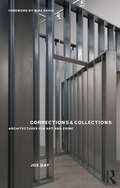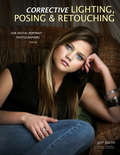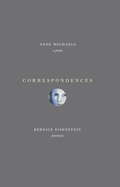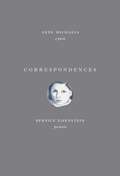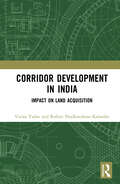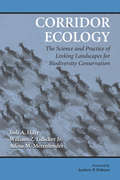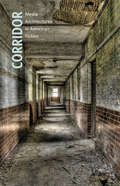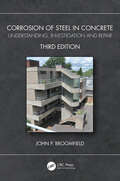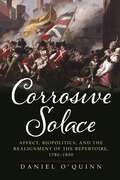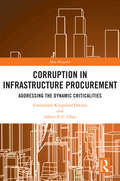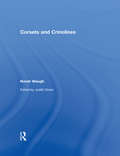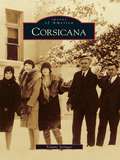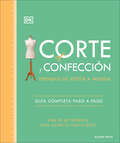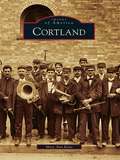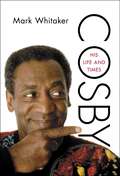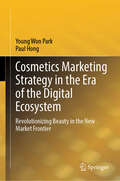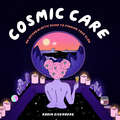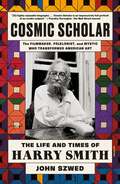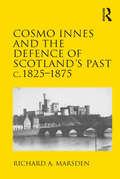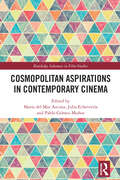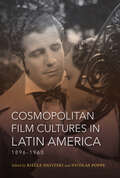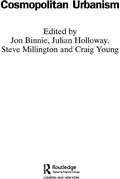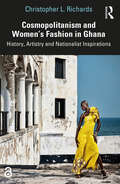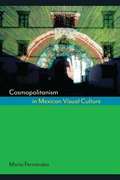- Table View
- List View
Corrections and Collections: Architectures for Art and Crime
by Joe DayAmerica holds more than two million inmates in its prisons and jails, and hosts more than two million daily visits to museums, figures which represent a ten-fold increase in the last twenty-five years. Corrections and Collections explores and connects these two massive expansions in our built environment. Author Joe Day shows how institutions of discipline and exhibition have replaced malls and office towers as the anchor tenants of U.S. cities. Prisons and museums, though diametrically opposed in terms of public engagement, class representation, and civic pride, are complementary structures, employing related spatial and visual tactics to secure and array problematic citizens or priceless treasures. Our recent demand for museums and prisons has encouraged architects to be innovative with their design, and experimental with their scale and distribution through our cities. Contemporary museums are the petri dishes of advanced architectural speculation; prisons remain the staging grounds for every new technology of constraint and oversight. Now that criminal and creative transgression are America’s defining civic priorities, Corrections and Collections will recalibrate your assumptions about art, architecture, and urban design.
Corrective Lighting, Posing & Retouching: For Digital Portrait Photographers
by Jeff SmithWith techniques for achieving a flawless portrait, this manual shows how to create stunning, professional images in any setting. Tips on how to delicately discuss and evaluate a subject’s appearance and his or her specific concerns combine with examples on how subtle changes in lighting and posing can flatter subjects#151;by slimming the waist and hips, enhancing the bust, narrowing the nose, reducing a double chin, and concealing baldness#151;helping portrait photographers sensitively downplay perceived flaws. Also illustrating how the latest in digital imaging technology can fix problems, this up-to-date resource shows how to digitally eliminate acne, whiten teeth, remove braces, and fix unnoticed clothing problems. Techniques for processing RAW files and for optimizing JPEG files for quick, but consistent, shooting are also included. With hundreds of new images, before-and-after sequences, and informative text, this is the ultimate reference for creating beautiful, flattering portraits.
Correspondences
by Anne Michaels Bernice EisensteinA rare and beautifully produced "accordion" book by renowned novelist and poet Anne Michaels and acclaimed artist and writer Bernice Eisenstein that will cause a stir for both its form and its content.Anne Michaels's resonant book-length poem--which unfolds on one side of the pages of this accordion book--ranges from the universal to the intimate, as she writes of historical figures for whom language was the closest thing to salvation; on the other side, we have Bernice Eisenstein's luminous portraits of and quotes from such twentieth-century writers and thinkers as Paul Celan, Nelly Sachs, W. G. Sebald, Anna Akhmatova, Primo Levi, and Albert Einstein. The poetry and portraits join together in a dialogue that can be read in any direction and any order, in a format that perfectly reflects the thematic interconnectedness of this collaboration: "an alphabet of spirits and spirit; an elegy of remembrance" (Eisenstein); "just as a conversation becomes the third side of the page . . . the moment one life becomes another" (Michaels).
Correspondences: A poem and portraits
by Anne Michaels Bernice EisensteinThis beautifully conceived book brings together the best-selling novelist and poet Anne Michaels and the acclaimed artist and writer Bernice Eisenstein in a unique, accordion-style format. Michaels' resonant book-length poem, a historical and personal elegy, unfolds on one side of the book's pages. On the other side, in unison with the poem, are Bernice Eisenstein's haunting portraits of the twentieth-century writers and thinkers Michaels' poem summons, for whom language was the closest thing to salvation: figures such as Paul Celan, Nelly Sachs, W. G. Sebald, Anna Akhmatova, Primo Levi, and Albert Einstein, each accompanied by quotations that illuminate the deeper connections among them. The poem is written to be read in sequence, as well as to join together with the portraits in a dialogue that perfectly reflects the thematic interconnectedness of this collaboration: 'an alphabet of spirits and spirit' (Eisenstein); 'the moment one life/becomes another' (Michaels). A stunning creation in both form and content, Correspondences is an unforgettable visual and poetic experience and a profound reflection on how the table of history is set by individuals.
Corridor Development in India: Impact on Land Acquisition
by Vinita Yadav Rohini Neelkanthrao KalambeThis book discusses the nuances of corridor development in India and its implications on land acquisition and displacement. It explores the complexities of land related conflicts and its socio-economic impacts on people’s lives. Examining the evolution of a few corridors of national importance like the Mumbai-Nagpur Expressway, Yamuna Expressway, Delhi-Mumbai Industrial Corridor, and Pune-Mumbai Expressway, the volume provides a comprehensive understanding of the dynamics of corridor development and regional growth. The book discusses how policies relating to land acquisition result in political, economic, legal and psychological hardships. The authors, using primary and secondary data, assess the socio-economic implications of land-acquisition on agriculture, employment, environment, demography, and land utilization along the regions touching these corridors. The work further discusses sustainable interventions in land acquisition practices to ensure equity of land and resources for vulnerable communities. The book will be useful for students and researchers of public policy, development studies, economics, urban and regional development studies and sociology. It will also be of interest to academicians, regional planners, and those working in the field of land development, resettlement and rehabilitation.
Corridor Ecology: The Science and Practice of Linking Landscapes for Biodiversity Conservation
by Adina Merenlender Jodi A. Hilty Andrew P. Dobson William Z. Lidicker Jr.Corridor Ecology presents guidelines that combine conservation science and practical experience for maintaining, enhancing, and creating connectivity between natural areas with an overarching goal of conserving biodiversity. It offers an objective, carefully interpreted review of the issues and is a one-of-a-kind resource for scientists, landscape architects, planners, land managers, decision-makers, and all those working to protect and restore landscapes and species diversity.
Corridor: Media Architectures in American Fiction
by Kate MarshallCorridor offers a series of conceptually provocative readings that illuminate a hidden and surprising relationship between architectural space and modern American fiction. By paying close attention to fictional descriptions of some of modernity&’s least remarkable structures, such as plumbing, ductwork, and airshafts, Kate Marshall discovers a rich network of connections between corridors and novels, one that also sheds new light on the nature of modern media.The corridor is the dominant organizational structure in modern architecture, yet its various functions are taken for granted, and it tends to disappear from view. But, as Marshall shows, even the most banal structures become strangely visible in the noisy communication systems of American fiction. By examining the link between modernist novels and corridors, Marshall demonstrates the ways architectural elements act as media. In a fresh look at the late naturalist fiction of the 1920s, &’30s, and &’40s, she leads the reader through the fetus-clogged sewers of Manhattan Transfer to the corpse-choked furnaces of Native Son and reveals how these invisible spaces have a fascinating history in organizing the structure of modern persons. Portraying media as not only objects but processes, Marshall develops a new idiom for Americanist literary criticism, one that explains how media studies can inform our understanding of modernist literature.
Corrosion of Steel in Concrete: Understanding, Investigation and Repair
by John P. BroomfieldCorrosion of Steel in Concrete: Understanding, Investigation and Repair is a guide for designing, constructing and maintaining reinforced concrete structures, such as buildings and bridges which are subject to reinforcement corrosion. It presents the basics of theory and practice in steel corrosion in concrete and reviews the latest research and developments, such as progress on measuring the corrosion threshold for chloride-induced corrosion. This third edition compares the currently proliferating major national and international standards and guidance documents. New developments are considered, such as hybrid anodes for electrochemical treatment and the latest research and developments in assessment, such as the use of ground penetrating radar to measure the chloride content of the concrete cover. It overhauls coverage of electrochemical repair and rehabilitation techniques and outlines recent innovations in structural repair and construction and investigates their implications for durability. The book is ideal for practitioners and graduate students in structural engineering and concrete technology.
Corrosive Solace: Affect, Biopolitics, and the Realignment of the Repertoire, 1780-1800
by Daniel O'QuinnIn Corrosive Solace, Daniel O’Quinn argues that the loss of the American colonies instantiated a complex reorganization in sociability and politics in the British metropole that has had long-lasting effects on British national and imperial culture, which can be seen and analyzed within its performative repertoire. He examines how the analysis of feeling or affect can be deployed to address the inchoate causal relation between historical events and their mediation. In this sense, Corrosive Solace’s goals are twofold: first, to outline the methodologies necessary for dealing with the affective recognition of historical crisis; and second, to make the historically familiar strange again, and thus make visible key avenues for discussion that have remained dormant. Both of these objectives turn on recognition: How do we theorize the implicit affective recognition of crisis in a distant historical moment? And how do we recognize what we, in our present moment, cannot discern?Corrosive Solace addresses this complex cultural reorientation by attending less to “new” cultural products than to the theoretical and historical problems posed by looking at the transformation of “old” plays and modes of performance. These “old” plays—Shakespeare, post-Restoration comedy and she-tragedy—were a vital plank of the cultural patrimony, so much of O’Quinn’s analysis lies in how tradition was recovered and redirected to meet urgent social and political needs. Across the arc of Corrosive Solace, he tracks how the loss of the American War forced Britons to refashion the repertoire of cultural signs and social dispositions that had subtended its first empire in the Atlantic world in a way more suited to its emergent empire in South Asia.
Corruption in Infrastructure Procurement: Addressing the Dynamic Criticalities (Spon Research)
by Albert P.C. Chan Emmanuel Kingsford OwusuThis book presents an extensive study on the extant constructs of corruption in infrastructure-related projects and aims to contribute to the determination and elimination of its incidence and prevalence in infrastructure projects. The book conducts a comprehensive examination of the various determining factors of corruption that negatively affect the procurement process and, in the end, result in cost and time overruns. The authors present an in-depth understanding of how the identified determining factors of corruption can be addressed. Thus, it is intended to broaden the reader's knowledge of the causes, risk indicators, and different forms of corrupt practices in the procurement process of infrastructure works, before explaining how they affect its stages and activities A dynamic model is developed to demonstrate how to tackle the overall impact of corruption within the procurement process and, at the same time, increase the effectiveness of the extant anti-corruption measures. In short, this book demonstrates that the fight against corruption in the procurement process is strategically feasible and must continue. This book is essential reading for academics, researchers, professionals and stakeholders in the procurement of infrastructure projects and civil works, as well as those with an interest in corruption, construction management and construction project management.
Corsets and Crinolines
by Norah Waugh Judith DolanIn this classic book, Norah Waugh explores the changing shapes of women’s dress from the 1500s to the 1920s. Simple laced bodices became corsets of cane, whalebone and steel, while padding at shoulders and hips gave way to the structures of farthingales, hoops and bustles. Corsets and Crinolines explains the cyclical nature of these fashions, and how waists and skirts changed shape and size through three distinct eras: The 1500s to 1670—farthingales and whaleboned bodies. 1670 to 1800—Stays and hooped petticoats. 1800 to 1925—corsets, crinolines and bustles. Each section describes how these garments originated, how they became popular and how they emerged as central to the fashions of the time. Extracts from diaries, journals, poems and newspapers, as well as over 100 illustrations, demonstrate the variety of these ubiquitous items of clothing throughout modern history. Corsets and Crinolines also contains a wealth of practical notes and resources for today’s costume makers and designers, including: Scaleable patterns for the construction of 25 different bustles, crinolines, corsets, corselets, stays, pocket hoops, hooped petticoats and bodices. Detailed appendices on the manufacture of corsets and crinolines, including farthingales, supports and hooped petticoats. A list of further reading, including costume histories; textile and weaving histories; reconstruction of period clothing; contemporary application of foundational garments; and a list of museums and institutions with period clothing collections, for first-hand study. A glossary of terms and materials.
Corsicana
by Dr Tommy StringerThe first Texas legislature created Navarro County in 1846 and named it in honor of Texas patriot Jose Antonio Navarro. When asked to name the new seat of government, Navarro replied, "Call it Corsicana for the island of Corsica, the birthplace of my father." From its beginnings in 1848, Corsicana's history has been marked by Texas icons such as cotton, cattle, and chili. The town's history took a dramatic turn when drillers looking for water struck oil instead in 1894. By the end of the decade, more than 500 wells dotted the landscape, marking the first commercial oil field in Texas and launching the industry that has become synonymous with the Lone Star State. Oil, business enterprises, and politics are important parts of Corsicana's legacy, but much of its history is found in the everyday events that make up the fabric of a community. Local history is filled with stories of people who overcame obstacles to fulfill the American Dream.
Corte y confección (The Tailoring Book): Prendas de vestir a medida
by Alison SmithTodo lo que necesitas saber para diseñar, crear y personalizar tu ropa Aprende las técnicas y los procesos básicos de confección y ensamblaje de prendas, perfecciona tu técnica y gana confianza y eficacia hasta dominar técnicas de alta costura más avanzadas como el montaje de mangas y cuellos, el entretelado o el forrado.Tanto si quieres alterar una prenda vintage como si deseas crear tu propia ropa desde cero, este libro de corte y confección es el manual de referencia que todos los aficionados de la moda necesitan:-Con más de 80 técnicas que pueden aplicarse tanto a la ropa femenina como a la masculina, desde la elección de patrones y tejidos hasta el ajuste y la confección.-Instrucciones paso a paso, ilustraciones y fotografías en gran formato y patrones descargables.-Consejos prácticos sobre medición, corte, alteración y acabado.-Información sobre el material y los útiles de costura necesarios para crear patrones, cortar telas y coser diferentes prendas y diferentes tejidos, a mano y a máquina.-10 proyectos para crear camisas, chaquetas, abrigos y pantalones a medida.Descubre los secretos de la confección de moda de la mano de una de las mayores expertas en sastrería del mundo y empieza a crear, renovar o reinventar prendas según tu estilo.---------------------------------------------Whether you want to alter a vintage jacket or create a full-tailored suit, this tailoring reference guide has everything you need to produce elegant, bespoke garments that last a lifetime.With over 80 step-by-step techniques on measuring, cutting, altering, and finishing, this is the only book you will need to create and alter a tailored garment.Alison Smith MBE is one of the world's leading tailoring experts, and in her new book, she reveals trade secrets and all the practical know-how necessary to master this heritage craft. The Tailoring Book is the latest title in Smith's best-selling sewing series. It covers everything from choosing patterns and fabrics to fitting and construction, including techniques that can be applied to both womens- and menswear.With this book, you can learn how to:-Tailor garments by selecting the right tools to create a toile and picking the perfect hand stitch.-Follow 10 detailed garment projects to create shirts, jackets, coats, and trousers-Master the techniques of tailoring with step-by-step instructions and downloadable patterns that guide you through every part of the processThis book includes key equipment and techniques, garment projects with clear step-by-step processes and downloadable patterns, and tips on repairs and alterations. It takes the reader from the basics through to couture techniques.
Cortland
by Mary Ann KaneWhen Cortland was incorporated as a village in 1853, its population was mainly transplanted New Englanders and Irish immigrants, and it encompassed territory 1 mile from east to west. By 1871, two rail lines crossed the village, and their cargos of coal encouraged the development of industries, particularly carriages and sleighs. The 1890s brought Cortland's first urban renewal with industrialists replacing wooden mansions with ones of brick, stone, and Queen Anne designs. The 20th century opened with full employment in industries that not only served the country but also the world. This encouraged Italians, Ukrainians, and Lebanese to settle in Cortland and share their heritage. Photographs from the archives of the Cortland County Historical Society illustrate how life was lived in Cortland before the 21st century.
Cosby: His Life and Times
by Mark WhitakerThe first major biography of an American icon, comedian Bill Cosby. Based on extensive research and in-depth interviews with Cosby and more than sixty of his closest friends and associates, it is a frank, fun and fascinating account of his life and historic legacy.Far from the gentle worlds of his routines or TV shows, Cosby grew up in a Philadelphia housing project, the son of an alcoholic, largely absent father and a loving but overworked mother. With novelistic detail, award winning journalist Mark Whitaker tells the story of how, after dropping out of high school, Cosby turned his life around by joining the Navy, talking his way into college, and seizing his first breaks as a stand-up comedian. Published on the 30th anniversary of The Cosby Show, the book reveals the behind-the-scenes story of that groundbreaking sitcom as well as Cosby's bestselling albums, breakout role on I Spy, and pioneering place in children's TV. But it also deals with professional setbacks and personal dramas, from an affair that sparked public scandal to the murder of his only son, and the private influence of his wife of fifty years, Camille Cosby. Whitaker explores the roots of Cosby's controversial stands on race, as well as "the Cosby effect" that helped pave the way for a black president. For any fan of Bill Cosby's work, and any student of American television, comedy, or social history, Cosby: His Life and Times is an essential read.
Cosmetics Marketing Strategy in the Era of the Digital Ecosystem: Revolutionizing Beauty in the New Market Frontier
by Young Won Park Paul HongThis book explores how cosmetics firms have made the transition to technology-enabled beauty companies to meet changing customer demands. For this purpose, the contexts of cosmetics industry growth and digital marketing strategy in the post-pandemic world are presented here. The digital marketing strategies of Japanese and Korean firms are shown, along with new business models and future prospects in cosmetics industries. In the post-pandemic world, the growing middle class will set priorities for beauty–hygienic goals, nutritional choices, and healthcare development needs. The growth rates of Asian economies were slowed during the COVID-19 pandemic, yet their growth opportunities were not constrained. Diverse industries—the cosmetics industry in particular—have addressed the needs of these growing segments in Asia. In keeping up with the leading business trends, cosmetics firms also have leveraged big data and built their brand partnerships across industries, applying the Internet of Things (IoT) and artificial intelligence for their product and process development. The vast amounts of big data gathered through IoT devices are now being used to improve entire value chain operations, creating a digital thread through the global value chain. These data are increasingly used to create new services and develop a business model for global firms. As of 2021, four of the top ten global cosmetics firms are from the USA (Estée Lauder, Proctor & Gamble, Coty, and Johnson & Johnson), three are from Europe (L’Oréal, Unilever, and Beiersdorf), two from Japan (Shiseido and Kao), and one from Korea (Amore Pacific). The USA and European firms still maintain their competitive advantage in the cosmetics industry. Global cosmetics market share by region shows that North Asia is the largest (35%), followed by North America (26%) and Latin America (7%), Europe (22%), and Africa and other regions (10%). With the rapid increase of the middle class in the Asia region, more sales are expected there than anywhere else. In this dynamic market environment, a real challenge for the cosmetics industry is how to develop and put into practice its own unique business model.
Cosmetology Fundamentals: A Designer's Approach Coursebook
by Pivot Point InternationalThe 21st century holds promise and unlimited opportunities for you, the professional cosmetologist. New techniques, new products and new opportunities appear every day. The numbers of people who visit beauty salons and the amount of money spent on beauty services are constantly increasing. If you are innovative and ambitious, there is no limit to your career potential. No other industry has such a constant demand for qualified, creative, well-trained graduates. None offers such bright opportunities for an individual to start a persona! business and work toward financial independence. Your artistic skills and training give you the potential for changing people's lives by making them look good and feel beautiful.
Cosmic Care: An Intergalactic Guide to Finding Your Glow
by Robin EisenbergFind gravitational stability and embrace your natural radiance with this intergalactic guide to self-care.Cosmic Care brings readers on a dreamy journey through space to reveal tips that will help them unlock their inner glow.Featuring the visionary art and signature style of Robin Eisenberg, Cosmic Care is an escape into a vivid, immersive universe that's simultaneously familiar, relatable, and out of this world.Filled with vibrant illustrations and never-before-seen art, Cosmic Care offers feel-good advice to relax, find peace, stop and smell the bioluminescent flora, and bring out your stellar luminosity.• Pairs bite-size pieces of advice with vibrant illustrations• Blends the earthly and the extraterrestrial• Offers a unique take on traditional self-careThe formation of a star begins with gravitational instability, but with a little cosmic care, it evolves into a luminous celestial object—and you can, too.• Great for fans of Robin Eisenberg's art and illustrations• A wonderful gift for anyone who loves self-care, the cosmos, astrology, and anything witchy• Add it to the shelf with books like Strange Planet by Nathan W. Pyle, Basic Witches by Jaya Saxena, and The Witch's Book of Self-Care: Magical Ways to Pamper, Soothe, and Care for Your Body and Spirit by Arin Murphy-Hiscock.
Cosmic Scholar: The Life and Times of Harry Smith
by John SzwedNamed one of the Best Books of 2023 by the New Yorker and The New York Times' Dwight Garner“The first comprehensive biography of this hipster magus . . . [John Szwed] allows different sides of Smith’s personality to catch blades of sun. He brings the right mixture of reverence and comic incredulity to his task.” —Dwight Garner, The New York TimesGrammy Award–winning music scholar and celebrated biographer John Szwed presents the first biography of Harry Smith, the brilliant eccentric who transformed twentieth century art and culture.He was an anthropologist, filmmaker, painter, folklorist, mystic, and walking encyclopedia. He taught Patti Smith and Robert Mapplethorpe about the occult, swapped drugs with Timothy Leary, had a front-row seat to a young Thelonious Monk, lived with (and tortured) Allen Ginsberg, was admired by Susan Sontag, and was one of the first artists funded by Guggenheim Foundation. He was always broke, generally intoxicated, compulsively irascible, and unimpeachably authentic. Harry Smith was, in the words of Robert Frank, “the only person I met in my life that transcended everything.”In Cosmic Scholar, the Grammy Award-winning music scholar and celebrated biographer John Szwed patches together, for the first time, the life of one of the twentieth century’s most overlooked cultural figures. From his time recording the customs of Native American tribes in the Pacific Northwest and Florida to his life in Greenwich Village in its heyday, Smith was consumed by an unceasing desire to create a unified theory of culture. He was an insatiable creator and collector, responsible for the influential Anthology of American Folk Music and several pioneering experimental films, but was also an insufferable and destructive eccentric who was unable to survive in regular society, or keep himself healthy or sober.Exhaustively researched, energetically told, and complete with a trove of images, Cosmic Scholar is a feat of biographical restoration and the long overdue canonization of an American icon.Includes black-and-white and color images
Cosmo Innes and the Defence of Scotland's Past c. 1825-1875
by Richard A. MarsdenToday, Scotland's history is frequently associated with the clarion call of political nationalism. However, in the nineteenth century the influence of history on Scottish national identity was far more ambiguous. How, then, did ideas about the past shape Scottish identity in a period when union with England was all but unquestioned? The activities of the antiquary Cosmo Innes (1798-1874) help us to address this question. Innes was a prolific editor of medieval and early modern documents relating to Scotland's parliament, legal system, burghs, universities, aristocratic families and pre-Reformation church. Yet unlike scholars today, he saw that editorial role in interventionist terms. His source editions were artificial constructs that powerfully articulated his worldview and agendas: emphasising Enlightenment-inspired narratives of social progress and institutional development. At the same time they used manuscript facsimiles and images of medieval architecture to foreground a romantic concern for the texture of past lives. Innes operated within an elite associational culture which gave him access to the leading intellectuals and politicians of the day. His representations of Scottish history therefore had significant influence and were put to work as commentaries on some of the major debates which exorcised Scotland's intelligentsia across the middle decades of the century. This analysis of Innes's work with sources, set within the intellectual context of the time and against the antiquarian activities of his contemporaries, provides a window onto the ways in which the 'national past' was perceived in Scotland during the nineteenth century. This allows us to explore how historical thinkers negotiated the apparent dichotomies between Enlightenment and Romanticism, whilst at the same time enabling a re-examination of prevailing assumptions about Scotland's supposed failure to maintain a viable national consciousness in the later 1800s.
Cosmopolitan Aspirations in Contemporary Cinema (Routledge Advances in Film Studies)
by Pablo Gómez-Muñoz Julia Echeverría María del Mar AzconaThis book presents cosmopolitanism as a useful methodological approach to understand the transnational synergies present in contemporary cinema.In line with existing literature from the social sciences, the volume aims to contribute to the ‘cosmopolitan turn’ in cinema studies. It considers cosmopolitanism as, among others, a personal and social aspiration of social justice, world citizenship and celebration of difference; a notion to be criticised as elitist, Western, often imperialist, and homogenising; and an actually existing social practice characterised by contradiction, messiness and conflict. The chapters in this volume offer insights into the variety of sometimes contradictory discourses that arise from a cosmopolitan interpretation of a wide variety of film texts. Key topics explored in this book include borders, (im)mobilities, migration, race, class and film aesthetics.This book will be particularly useful to film studies scholars and students looking at transnational, global, world and decolonial cinemas and focusing on topics like borders, migration and multiculturalism in film. This book will also appeal to academic communities studying media, literature, mobilities, geopolitics, sociology and the social sciences in general.
Cosmopolitan Film Cultures in Latin America, 1896–1960 (New Directions in National Cinemas)
by Rielle Navitski and Nicolas PoppeCosmopolitan Film Cultures in Latin America examines how cinema forged cultural connections between Latin American publics and film-exporting nations in the first half of the twentieth century. Predating today's transnational media industries by several decades, these connections were defined by active economic and cultural exchanges, as well as longstanding inequalities in political power and cultural capital. The essays explore the arrival and expansion of cinema throughout the region, from the first screenings of the Lumière Cinématographe in 1896 to the emergence of new forms of cinephilia and cult spectatorship in the 1940s and beyond. Examining these transnational exchanges through the lens of the cosmopolitan, which emphasizes the ethical and political dimensions of cultural consumption, illuminates the role played by moving images in negotiating between the local, national, and global, and between the popular and the elite in twentieth-century Latin America. In addition, primary historical documents provide vivid accounts of Latin American film critics, movie audiences, and film industry workers' experiences with moving images produced elsewhere, encounters that were deeply rooted in the local context, yet also opened out onto global horizons.
Cosmopolitan Urbanism
by Jon Binnie Steve Millington Julian Holloway Craig YoungIn order to attract investment and tourism, cities are increasingly competing to re-brand themselves as cosmopolitan, and in recent years, cosmopolitanism has become the focus of considerable critical attention in academia. Here, renowned editors and contributors have come together to produce one of the first books to tackle cosmopolitanism from a geographical perspective. Central to the cosmopolitan process is how traditionally marginalized groups have become re-valued and reconstructed as a resource in the eyes of planners and politicians. This fascinating book examines the politics of these transformations by understanding the everyday practices of cosmopolitanism. Which forms of cultural difference are valued and which are excluded from this re-visioning of the contemporary city? Organized in three distinct parts, the book covers: production and consumption, and cosmopolitanism the spatialities of cosmopolitanism the deployment, mobilization and articulation of cosmopolitan discourses in policy-making and urban design. The volume is groundbreaking in examining the complex politics of cosmopolitanism in empirical case studies from Montreal to Singapore, London to Texas, Auckland to Amsterdam. With a strong editorial steer, including general and section introductions and a conclusion to guide the student reader, Cosmopolitan Urbanism employs a range of theoretical and empirical approaches to provide a grounded treatment essential for students of human geography, urban studies and sociology.
Cosmopolitanism and Women’s Fashion in Ghana: History, Artistry and Nationalist Inspirations
by Christopher L. RichardsDrawing on extensive archival research and interviews, this book delves into the rich world of Ghanaian fashion, demonstrating how, over time, local dress styles and materials have been fused with global trends to create innovative, high fashion garments that reflect a distinctly Ghanaian cosmopolitanism. Ghana has a complex and diverse fashion culture which was in evidence before independence in 1957 and has continued to grow in reputation in the postcolonial period. In this book, Christopher Richards reflects on the contributions of the country’s female fashion designers, who have employed fashion to innovate existing, culturally relevant dress styles, challenge gendered forms of dress, and make bold statements regarding women’s sexuality. Treated as artworks, the book examines specific garments to illustrate the inherent complexity of their design and how fashion is often embedded with a blending of personal histories, cultural practices and global inspirations. Reflecting in particular on the works of Laura Quartey, Letitia Obeng, Juliana Kweifio-Okai, Beatrice Arthur and Aisha Ayensu, this book makes an important and timely contribution to art history, fashion studies, anthropology, history, women’s studies and African Studies.
Cosmopolitanism in Mexican Visual Culture
by María FernándezShe argues that in Mexico, as in other colonized regions, colonization constructed power dynamics and forms of violence that persisted in the independent nation-state. Accordingly, Fernández presents not only the visual qualities of objects, but also the discourses, ideas, desires, and practices that are fundamental to the very existence of visual objects.
